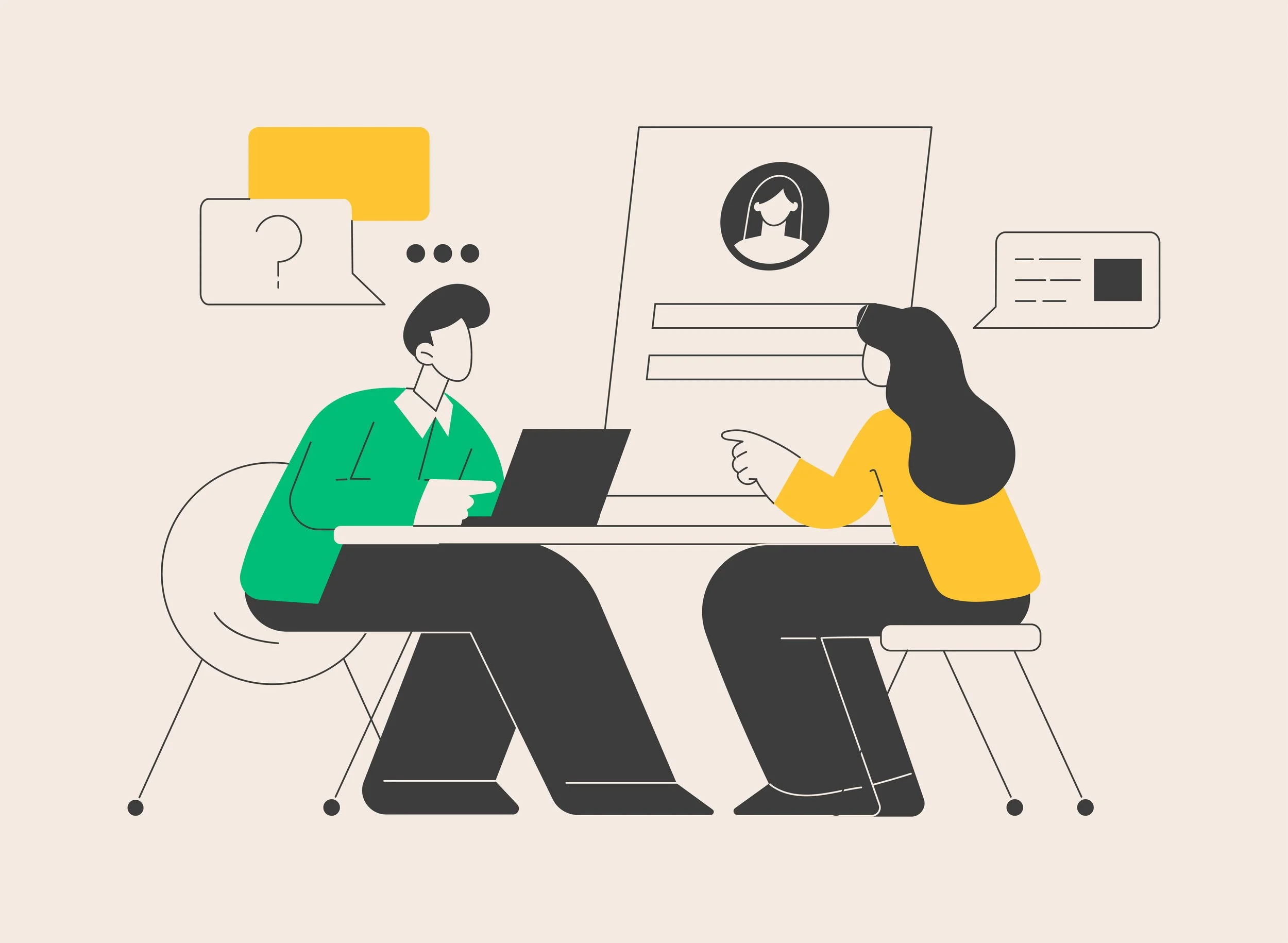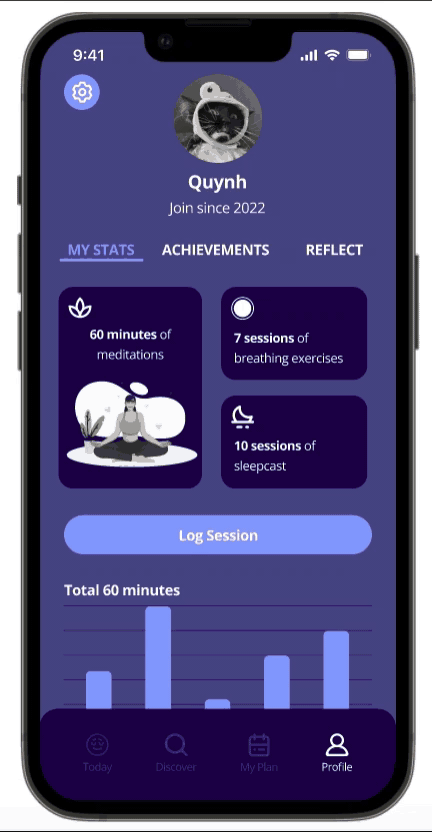Customizable Meditation App
PROJECT DETAIL
General Assembly 2022
UI/UX Final Project
DELIVERABLES
User Research, Usability Testing, Prototype, Presentation Pitch
ROLE
UI/UX Designer
TIME
April - June 2022
Overview
Peace of Mind is my capstone project for General Assembly’s UX Design Certification program. The project’s goal is to help users build sustainable meditation habits through customizable sessions. It was initially a Buddhist-inspired meditation app but evolved into a user-driven experience based on research and usability testing. With strong competition from mainstream meditation apps, our app needed to take a unique approach to make meditation more accessible and adaptable to users’ lifestyles.
Background
Main UI/UX Designer.
Created wireframes, interactive prototypes, branding, and styleguide.
At the end of the program, I delivered a 15 minute presentation pitching the project to my instructor and peers.
My Role
Create a meditation app that makes meditation easy to stick with by allowing users to customize sessions to fit their schedules.
Focus on flexibility and habit-building rather than structured meditation sessions.
Help users meditate on their own terms without them feeling pressured.
Goals
How can Peace of Mind be unique and compete with existing mainstream meditation apps?
Manage time constraints while designing a full UI/UX project from scratch within the course timeline.
Navigating unlimited design possibilities - having full creative freedom.
Challenges
Discover: Understanding Our Users
Meditation is known to offer many benefits, from reducing stress to increasing self-awareness.
However, many people struggle to maintain a consistent meditation habit, often feeling discouraged or guilty when they don’t meet certain progress milestones set by mainstream meditation apps.
As someone who has experienced this frustration firsthand, I wanted to create a meditation platform that removes the pressure, eliminates the pressure of meeting certain achievements and milestones. Instead, focus on helping users build their own meditation routines and prioritize user actions over milestones. Offering an encouraging experience that adapts to individuals’ lifestyles and needs.
Problem Statement
How might we help people create customizable meditation experiences that fit their lifestyle and habits?
How might we encourage people to achieve their goals without making them feel guilty or bad for missing their routines/plans?
How might we design an experience that adapts to different levels, from beginners to experienced meditators?
Questions
Competitive Analysis
Before scheduling my user interviews, I spent time organizing my discussion guide to prepare for my 1:1 interview. My discussion guide includes questions about users’ backgrounds, routines, opinions on the current app (if they are using a meditation app), their opinions on their likes and dislikes, and their motivations.
Overall, these key findings have given more understanding of why maintaining a meditation routine is a challenge for some people.
User Interviews
Key Insights
Users meditate mainly to relax and destress from work.
“Working for long hours, it’s very stressful, and I just want some time to myself.”
“To deal with these situations, I normally would listen to music and meditate to relax.”
Users prefer an easy-to-use meditation app that fits their busy schedules.
“I would keep using it if the app is easy to navigate.”
“I think the app itself is pretty great… It’s quite flexible for busy people like me.”
Some users struggle to maintain meditation habits due to lack of patience or time.
“I don’t have enough patience and I’m busy.”
“Keeping a habit and scheduling is the hardest part about meditation.”
“Normally, I prioritize my work over meditation unless I’m too overwhelmed.”
Define: Identifying Users & Features
After conducting research to understand the users of meditation apps and the challenges they face. My goal for this Define phase was to figure out who they are, what they need, and why they struggle to stay consistent.
Through interviews and competitive analysis, I found that most users want a simple, flexible meditation experience that fits into their busy schedules. This helped me focus on what motivates them, what holds them back, and how they currently engage with meditation apps, so I could design something that actually will help them.
Persona Development
Persona 1
First-time meditator
Persona 2
Some experience with meditation
Feature Analysis
Prioritize features based on impact vs. effort
Develop: Designing a Solution
With my goals, users, and features defined, I was ready to start wireframing. I needed to determine how users would navigate the app so I mapped out a user-flow to visualize their journey. This helped me structure the experience, ensuring that people could customize their meditation sessions without any problem.
Userflow
Sketches
Wireframes
Key Findings
Overall, 80% of users successfully completed the task, indicating that the core navigation was working well for most participants.
63% of testers had prior experience with meditation apps, with most using them once a week.
Users expected a notification or confirmation after editing their meditation session, suggesting the need for clearer feedback mechanisms.
Usability Testing
Pain Points Identified
High misclick rate (45.8%) - Users tapped the wrong areas, this means there’s a potential issue with the UI design.
Drop-off rate (20%) - Some users abandoned the task, suggesting confusion in the flow or unclear CTA for next steps.
Low expected path success rate (60%) - Only 60% of participants followed the intended flow, meaning that others took unexpected routes or struggled to complete the task.
Screen 3 (homepage) had the lowest usability score (14/100) - Heatmap analysis showed unclear touchpoints leading to high task drop-offs.
Now What?
After analyzing the usability test results, I focused on refining the customization flow to improve navigation.
Simplified the steps to ensure users could edit their meditation plan with fewer distractions.
Redesigned User Flow
Updated Sketches
Deliver: Finalizing the Design & Prototype
The visual identity of Peace of Mind is designed to feel calm, intuitive, and supportive. Meditation should be a stress-free experience, and I wanted the UI to reflect that.
I played with a deep purple and soft blue color palette to create a balance between focus and relaxation. The purples ground the experience, while the lighter blues bring in a sense of ease and openness. For typography, I chose Open Sans—a clean and modern typeface that keeps everything feeling light and approachable.
I had some fun with the navigation design, making sure it felt simple and effortless. Each element is meant to guide users without overwhelming them, reinforcing the idea that meditation should fit seamlessly into their day.
Style Guide
Final Design
Users can build sustainable habits through customizable meditation sessions or routines.
Meditation Routine Customization
Help our users stay motivated by progress tracking, mood loggings, and celebrating personal milestones like completed sessions, or personal milestones.
Dashboard
Explore Content Library
Users can browse meditation sessions tailored to different goals.
Reflection
Peace of Mind is my first full-scope project - from research and branding to final high-fidelity designs and design style guide. Moving forward, I hope to test the app with a more diverse group of participants to better understand how people interact with the current customization experience. The more feedback I can get, the more improvements I can consider for our users.
Next Step
This project challenged and strengthened my skills in both user research and visual design. I learned how to structure interviews, conduct usability testing, and build a design style guide in Figma. It was a great experience that gave me confidence in taking a project from concept to final design, and I’m excited to keep growing with future work.
Thank you for taking the time to read through the Peace of Mind Case Study.
What I Learned


